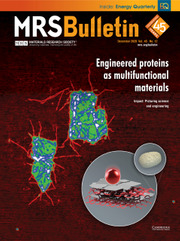Crossref Citations
This article has been cited by the following publications. This list is generated based on data provided by
Crossref.
Bijker, M.D.
Visser, E.M.
and
Lodder, J.C.
1998.
Oblique metal deposited thin films for magnetic recording.
Tribology International,
Vol. 31,
Issue. 9,
p.
553.
Messier, Russell
and
Lakhtakia, Akhlesh
1999.
Sculptured thin films—II. Experiments and applications.
Materials Research Innovations,
Vol. 2,
Issue. 4,
p.
217.
Ennas, G.
Marongiu, G.
Musinu, A.
Falqui, A.
Ballirano, P.
and
Caminiti, R.
1999.
Characterization of Nanocrystalline γ–Fe2O3Prepared by Wet Chemical Method.
Journal of Materials Research,
Vol. 14,
Issue. 4,
p.
1570.
Solinas, S
Piccaluga, G
Morales, M.P
and
Serna, C.J
2001.
Sol-gel formation of γ-Fe2O3/SiO2 nanocomposites.
Acta Materialia,
Vol. 49,
Issue. 14,
p.
2805.
Lodder, J.C.
2001.
Encyclopedia of Materials: Science and Technology.
p.
5350.
Amils, X.
Nogués, J.
Suriñach, S.
Muñoz, J. S.
Baró, M. D.
Hernando, A.
and
Morniroli, J. P.
2001.
Tailoring of paramagnetic (structurally ordered) nanometric grains separated by ferromagnetic (structurally disordered) grain boundaries: Isolating grain-boundary magnetic effects.
Physical Review B,
Vol. 63,
Issue. 5,
Weidenfeller, Bernd
Höfer, Michael
and
Schilling, Frank
2002.
Thermal and electrical properties of magnetite filled polymers.
Composites Part A: Applied Science and Manufacturing,
Vol. 33,
Issue. 8,
p.
1041.
Tartaj, Pedro
and
Serna, Carlos J.
2002.
Microemulsion-Assisted Synthesis of Tunable Superparamagnetic Composites.
Chemistry of Materials,
Vol. 14,
Issue. 10,
p.
4396.
KONDO, Hirofumi
2002.
Surface analysis of magnetic thin film media.
Bunseki kagaku,
Vol. 51,
Issue. 8,
p.
569.
Tartaj, Pedro
González-Carreño, Teresita
and
Serna, Carlos J.
2002.
Synthesis of Nanomagnets Dispersed in Colloidal Silica Cages with Applications in Chemical Separation.
Langmuir,
Vol. 18,
Issue. 12,
p.
4556.
Klug, Kevin L.
Dravid, Vinayak P.
and
Johnson, D. Lynn
2003.
Silica-encapsulated magnetic nanoparticles formed by a combined arc evaporation/chemical vapor deposition technique.
Journal of Materials Research,
Vol. 18,
Issue. 4,
p.
988.
Caizer, C.
Savii, C.
and
Popovici, M.
2003.
Magnetic behaviour of iron oxide nanoparticles dispersed in a silica matrix.
Materials Science and Engineering: B,
Vol. 97,
Issue. 2,
p.
129.
Núñez, Nuria O.
Tartaj, Pedro
Morales, M. Puerto
Pozas, Raul
Ocaña, Manuel
and
Serna, Carlos J.
2003.
Preparation, Characterization, and Magnetic Properties of Fe-Based Alloy Particles with Elongated Morphology.
Chemistry of Materials,
Vol. 15,
Issue. 18,
p.
3558.
Mano, João F.
Denchev, Zlatan
Nogales, Aurora
Bruix, Marta
and
Ezquerra, Tiberio A.
2003.
The Effect of Transreactions on the Structure and Dynamic Mechanical Properties of 1:1 Poly(ethylene terephthalate)/Poly(ethylene 2,6‐naphthalate) Blends Produced by Cryogenic Mechanical Alloying.
Macromolecular Materials and Engineering,
Vol. 288,
Issue. 10,
p.
778.
Woo, Kyoungja
Hong, Jangwon
Choi, Sungmoon
Lee, Hae-Weon
Ahn, Jae-Pyoung
Kim, Chul Sung
and
Lee, Sang Won
2004.
Easy Synthesis and Magnetic Properties of Iron Oxide Nanoparticles.
Chemistry of Materials,
Vol. 16,
Issue. 14,
p.
2814.
Weidenfeller, Bernd
Riehemann, Werner
and
Lei, Qiaohui
2004.
Mechanical spectroscopy of polymer-magnetite composites.
Materials Science and Engineering: A,
Vol. 370,
Issue. 1-2,
p.
278.
Núñez, Nuria O.
Tartaj, Pedro
Morales, M. Puerto
Bonville, Pierre
and
Serna, Carlos J.
2004.
Yttria-Coated FeCo Magnetic Nanoneedles.
Chemistry of Materials,
Vol. 16,
Issue. 16,
p.
3119.
Pozas, Raúl
Ocaña, Manuel
Morales, M Puerto
Tartaj, Pedro
Nuñez, Nuria O
and
Serna, Carlos J
2004.
Synthesis of acicular Fe–Co nanoparticles and the effect of Al addition on their magnetic properties.
Nanotechnology,
Vol. 15,
Issue. 4,
p.
S190.
Greulich-Weber, Siegmund
and
Marsmann, Heinrich
2005.
Ordered Porous Nanostructures and Applications.
p.
109.
Pozas, Raúl
Ocaña, Manuel
Morales, M Puerto
and
Serna, Carlos J
2006.
The influence of protective coatings on the magnetic properties of acicular iron nanoparticles.
Nanotechnology,
Vol. 17,
Issue. 5,
p.
1421.


